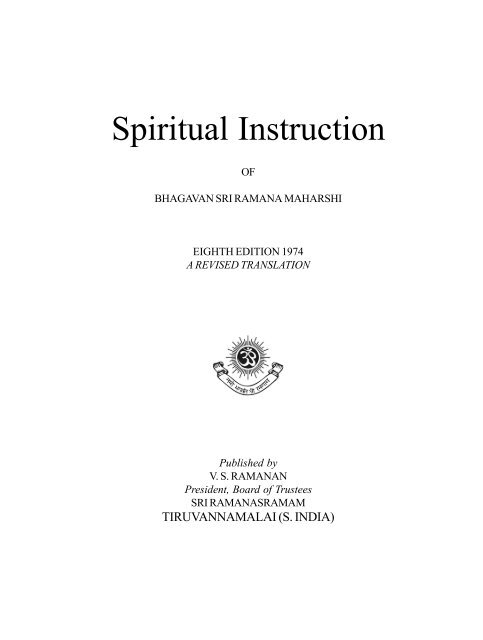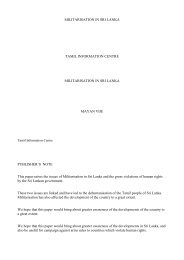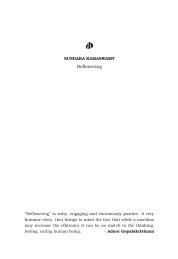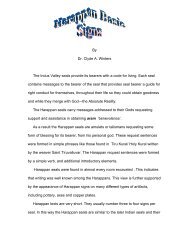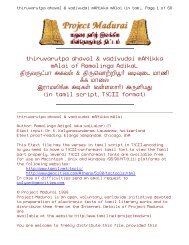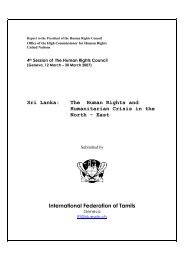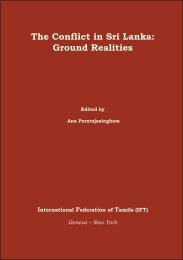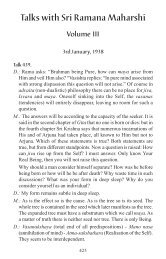Spiritual Instruction - Enlightened Beings
Spiritual Instruction - Enlightened Beings
Spiritual Instruction - Enlightened Beings
- No tags were found...
You also want an ePaper? Increase the reach of your titles
YUMPU automatically turns print PDFs into web optimized ePapers that Google loves.
concentrated and diffused simultaneously. When one is in dhyana it does not contact the objectsof the senses, and when it is in contact with the objects it is not in dhyana. Therefore those whoare in this state can observe the vagaries of the mind then and there and by stopping the mind fromthinking other thoughts, fix it in dhyana. Perfection in dhyana is the state of abiding in the Self(lit., abiding in the form of ‘that’ tadakaranilai) .As meditation functions in an exceedingly subtle manner at the source of the mind it is not difficultto perceive its rise and subsidence.(iv) yoga: The source of the breath is the same as that of the mind; therefore the subsidence ofeither leads effortlessly to that of the other. The practice of stilling the mind through breath control(pranayama) is called yoga.Fixing their minds on psychic centres such as the sahasrara (lit. the thousand-petalled lotus)yogis remain any length of time without awareness of their bodies. As long as this state continuesthey appear to be immersed in some kind of joy. But when the mind which has become tranquilemerges (becomes active again) it resumes its worldly thoughts. It is therefore necessary to trainit with the help of practices like dhyana, whenever it becomes externalised. It will then attain astate in which there is neither subsidence nor emergence.(v) jnana is the annihilation of the mind in which it is made to assume the form of the Self throughthe constant practice of dhyana or enquiry (vichara). The extinction of the mind is the state inwhich there is a cessation of all efforts. Those who are established in this state never swerve fromtheir true state. The terms ‘silence’ (mouna) and inaction refer to this state alone.____________________________________________NOTE: (1) All practices are followed only with the object of concentrating the mind. As all the mentalactivities like remembering, forgetting, desiring, hating, attracting, discarding, etc., are modifications of themind, they cannot be one’s true state. Simple, changeless being is one’s true nature. Therefore to know thetruth of one’s being and to be it, is known as release from bondage and the destruction of the knot (granthinasam). Until this state of tranquillity of mind is firmly attained, the practice of unswerving abidance in theSelf and keeping the mind unsoiled by various thoughts, is essential for an aspirant.(2) Although the practices for achieving strength of mind are numerous, all of them achieve the same end.For it can be seen that whoever concentrates his mind on any object, will, on the cessation of all mentalconcepts, ultimately remain merely as that object. This is called successful meditation (dhyana siddhi).Those who follow the path of enquiry realize that the mind which remains at the end of the enquiry isBrahman. Those who practise meditation realize that the mind which remains at the end of the meditationis the object of their meditation. As the result is the same in either case it is the duty of aspirants to practisecontinuously either of these methods till the goal is reached.4. Is the state of ‘being still’ a state involving effort or effortless?It is not an effortless state of indolence. All mundane activities which are ordinarily called effortare performed with the aid of a portion of the mind and with frequent breaks. But the act ofcommunion with the Self (atma vyavahara) or remaining still inwardly is intense activity whichis performed with the entire mind and without break.
Maya (delusion or ignorance) which cannot be destroyed by any other act is completely destroyedby this intense activity which is called ‘silence’ (mouna).5. What is the nature of maya?Maya is that which makes us regard as non-existent the Self, the Reality, which is always andeverywhere present, all-pervasive and self-luminous, and as existent the individual soul (jiva),the world (jagat), and God (para) which have been conclusively proved to be non-existent at alltimes and places.6. As the Self shines fully of its own accord why is it not generally recognised like the otherobjects of the world by all persons?Wherever particular objects are known it is the Self which has known itself in the form of thoseobjects. For what is known as knowledge or awareness is only the patency of the Self (atmasakti). The Self is the only sentient object. There is nothing apart from the Self. If there are suchobjects they are all insentient and therefore cannot either know themselves or mutually know oneanother. It is because the Self does not know its true nature in this manner that it seems to beimmersed and struggling in the ocean of birth (and death) in the form of the individual soul.7. Although the Lord is all-pervasive it appears, from passages like “adorning him through HisGrace”, that He can be known only through His grace. How then can the individual soul by itsown efforts attain self-realization in he absence of the Lord’s Grace?As the Lord denotes the Self and as Grace means the Lord’s presence or revelation, there is notime when the Lord remains unknown. If the light of the sun is invisible to the owl it is only thefault of that bird and not of the sun. Similarly can the unawareness by ignorant persons of the Selfwhich is always of the nature of awareness be other than their own fault? How can it be the faultof the Self? It is because Grace is of the very nature of the Lord that He is well-known as ‘theblessed Grace’. Therefore the Lord, whose nature itself is Grace, does not have to bestow HisGrace. Nor is there any particular time for bestowing His Grace.8. What part of the body is the abode of the Self?The heart on the right side of the chest is generally indicated. This is because we usually point tothe right side of the chest when we refer to ourselves. Some say that the sahasrara (the thousandpetalledlotus) is the abode of the Self. But if that were true the head should not fall forward whenwe go to sleep or faint.9. What is the nature of the heart?The sacred texts describing it say:Between the two nipples, below the chest and above the abdomen, there are six organs of differentcolours 1 . One of them resembling the bud of a water lily and situated two digits to the right is the
heart. It is inverted and within it is a tiny orifice which is the seat of dense darkness (ignorance)full of desires. All the psychic nerves (nadis) depend upon it. It is the abode of the vital forces, themind and the light (of consciousness). (See Appendix to Reality in Forty Verses 18 -19).______________________________1. These are not the same as the Chakras.But, although it is described thus, the meaning of the word heart (hrdayam) is the Self (atman). Asit is denoted by the terms existence, consciousness, bliss, eternal and plenum (sat, chit, anandam,nityam, purnam) it has no differences such as exterior and interior or up and down. That tranquilstate in which all thoughts come to an end is called the state of the Self. When it is realized as it is,there is no scope for discussions about its location inside the body or outside.10. Why do thoughts of many objects arise in the mind even when there is no contact withexternal objects?All such thoughts are due to latent tendencies (purva samskaras). They appear only to the individualconsciousness (jiva) which has forgotten its real nature and become externalised. Wheneverparticular things are perceived, the enquiry “Who is it that sees them”? should be made; they willthen disappear at once.11. How do the triple factors (i.e., knower, known and knowledge), which are absent in deepsleep, samadhi, etc., manifest themselves in the Self (in the states of waking and dreaming)?From the Self there arise in succession(i) Chidabhasa (reflected consciousness) which is a kind of luminosity.(ii) Jiva (the individual consciousness) or the seer or the first concept.(iii) Phenomena, that is the world.12. Since the Self is free from the notions of knowledge and ignorance how can it be said topervade the entire body in the shape of sentience or to impart sentience to the senses?Wise men say that there is a connection between the source of the various psychic nerves and theSelf, that this is the knot of the heart, that the connection between the sentient and the insentientwill exist until this is cut asunder with the aid of true knowledge, that just as the subtle andinvisible force of electricity travels through wires and does many wonderful things, so the forceof the Self also travels through the psychic nerves and, pervading the entire body, imparts sentienceto the senses, and that if this knot is cut the Self will remain as it always is, without any attributes.13. How can there be a connection between the Self which is pure knowledge and the triplefactors which are relative knowledge?This is, in a way, like the working of a cinema as shown below:-
CINEMA SHOWSELF1/2/3/4/5/6/7/The lamp inside (the apparatus)The lens in front of the lampThe film which is a long series of (separatephotos).The lens, the light passing through it and thelamp, which together form the focused light.The light passing through the lens and falling onthe screen.The various kinds of pictures appearing in thelight of the screen.The mechanism which sets the film in motion.1/2/3/4/5/6/7/The SelfThe pure (sattvic) mind close to the Self.The stream of latent tendencies consisting ofsubtle thoughts.The mind, the illumination of it and the Self,which together form the seer or the Jiva.The light of the Self emerging from the mindthrough the senses, and falling on the world.The various forms and names appearing as theobjects perceived in the light of the world.The divine law manifesting the latent tendenciesof the mind.Just as the pictures appear on the screen as long as the film throws the shadows through the lens,so the phenomenal world will continue to appear to the individual in the waking and dream statesas long as there are latent mental impressions. Just as the lens magnifies the tiny specks on the filmto a huge size and as a number of pictures are shown in a second, so the mind enlarges the sproutliketendencies into tree-like thoughts and shows in a second innumerable worlds. Again, just asthere is only the light of the lamp visible when there is no film, so the Self alone shines without thetriple factors when the mental concepts in the form of tendencies are absent in the states of deepsleep, swoon and samadhi. Just as the lamp illumines the lens, etc., while remaining unaffected,the Self illumines the ego (chidabhasa), etc., while remaining unaffected.14. What is dhyana (meditation)?It is abiding as one’s Self without swerving in any way from one’s real nature and without feelingthat one is meditating. As one is not in the least conscious of the different states (waking, dreaming,etc.) in this condition, the sleep (noticeable) here is also regarded as dhyana.15. What is the difference between dhyana and samadhi?Dhyana is achieved through deliberate mental effort; in samadhi there is no such effort.16. What are the factors to be kept in view in dhyana ?It is important for one who is established in his Self (atma nista) to see that he does not swerve inthe least from this absorption. By swerving from his true nature he may see before him brighteffulgences, etc., or hear (unusual) sounds or regard as real the visions of gods appearing withinor outside himself. He should not be deceived by these and forget himself.____________________________________________NOTE: (i) If the moments that are wasted in thinking of the objects which are not the Self, are spent onenquiry into the Self, Self-Realization will be attained in a very short time.(ii) Until the mind becomes established in itself some kind of bhavana (contemplation of a personified godor goddess with deep emotion and religious feeling) is essential. Otherwise the mind will be frequentlyassailed by wayward thoughts or sleep.
(iii) Without spending all the time in practising bhavanas like ‘I am Siva’ or ‘I am Brahman’, which areregarded as nirgunopasana (contemplation of the attributeless Brahman), the method of enquiry intooneself should be practised as soon as the mental strength which is the result of such upasana (contemplation)is attained.(iv) The excellence of the practice (sadhana) lies in not giving room for even a single mental concept (vritti)17. What are the rules of conduct which an aspirant (sadhaka) should follow?Moderation in food, moderation in sleep and moderation in speech.18. How long should one practice?Until the mind attains effortlessly its natural state of freedom from concepts, that is till the sense of‘I’ and ‘mine’ exists no longer.19. What is the meaning of dwelling in solitude (ekanta vasa)?As the Self is all-pervasive it has no particular place for solitude. The state of being free frommental concepts is called ‘dwelling in solitude’.20. What is the sign of wisdom (viveka)?Its beauty lies in remaining free from delusion after realising the truth once. There is fear only forone who sees at least a slight difference in the Supreme Brahman. So long as there is the idea thatthe body is the Self one cannot be a realizer of truth whoever he might be.21. If everything happens according to karma (prarabdha: the result of one’s acts in the past)how is one to overcome the obstacles to meditation (dhyana)?Prarabdha concerns only the out-turned, not the in-turned mind. One who seeks his real Self willnot be afraid of any obstacle.22. Is asceticism (sanyasa) one of the essential requisites for a person to become established inthe Self (atma nista)?The effort that is made to get rid of attachment to one’s body is really towards abiding in the Self.Maturity of thought and enquiry alone removes attachment to the body, not the stations of life(asramas), such as student (brahmachari), etc. For the attachment is in the mind while the stationspertain to the body. How can bodily stations remove the attachment in the mind? As maturity ofthought and enquiry pertain to the mind these alone can, by enquiry on the part of the same mind,remove the attachments which have crept into it through thoughtlessness. But, as the discipline ofasceticism (sanyasasrama) is the means for attaining dispassion (vairagya), and as dispassion isthe means for enquiry, joining an order of ascetics may be regarded, in a way, as a means ofenquiry through dispassion. Instead of wasting one’s life by entering the order of ascetics beforeone is fit for it, it is better to live the householder’s life. In order to fix the mind in the Self which
is its true nature it is necessary to separate it from the family of fancies (samkalpas) and doubts(vikalpas), that is to renounce the family (samsara) in the mind. This is the real asceticism.23. It is an established rule that so long as there is the least idea of I-am-the-doer, Self-knowledgecannot be attained, but is it possible for an aspirant who is a householder to discharge hisduties properly without this sense?As there is no rule that action should depend upon a sense of being the doer it is unnecessary todoubt whether any action will take place without a doer or an act of doing. Although the officer ofa government treasury may appear, in the eyes of others, to be doing his duty attentively andresponsibly all day long, he will be discharging his duties without attachment, thinking ‘I have noreal connection with all this money’ and without a sense of involvement in his mind. In the samemanner a wise householder may also discharge without attachment the various household dutieswhich fall to his lot according to his past karma, like a tool in the hands of another. Action andknowledge are not obstacles to each other.24. Of what use to his family is a wise householder who is unmindful of his bodily comforts andof what use is his family to him?Although he is entirely unmindful of his bodily comforts, if, owing to his past karma, his familyhave to subsist by his efforts, he may be regarded as doing service to others. If it is askedwhether the wise man derives any benefit from the discharge of domestic duties, it may beanswered that, as he has already attained the state of complete satisfaction which is the sumtotal of all benefits and the highest good of all, he does not stand to gain anything more bydischarging family duties.25. How can cessation of activity (nivritti) and peace of mind be attained in the midst of householdduties which are of the nature of constant activity?As the activities of the wise man exist only in the eyes of others and not in his own, although hemay be accomplishing immense tasks, he really does nothing. Therefore his activities do not standin the way of inaction and peace of mind. For he knows the truth that all activities take place in hismere presence and that he does nothing. Hence he will remain as the silent witness of all theactivities taking place.26. Just as the Sage’s past karma is the cause of his present activities will not the impressions(vasanas) caused by his present activities adhere to him in future?Only one who is free from all the latent tendencies (vasanas) is a Sage. That being so how can thetendencies of karma affect him who is entirely unattached to activity?27. What is the meaning of brahmacharya?Only enquiry into Brahman should be called brahmacharya.
28. Will the practice of brahmacharya which is followed in conformity with the (four) orders oflife (asramas) be a means of knowledge?As the various means of knowledge, such as control of senses, etc., are included in brahmacharyathe virtuous practices duly followed by those who belong to the order of students (brahmacharins)are very helpful for their improvement.29. Can one enter the order of ascetics (sanyasa) directly from the order of students(brahmacharya)?Those who are competent need not formally enter the orders of brahmacharya, etc., in the orderlaid down. One who has realized his Self does not distinguish between the various orders of life.Therefore no order of life either helps or hinders him.30. Does an aspirant (sadhaka) lose anything by not observing the rules of caste and orders oflife?As the attainment (anusthana, lit. practice) of knowledge is the supreme end of all other practices,there is no rule that one who remains in any one order of life and constantly acquires knowledgeis bound to follow the rules laid down for that order of life. If he follows the rules of caste andorders of life he does so for the good of the world. He does not derive any benefit by observing therules. Nor does he lose anything by not observing them.1. What is the light of consciousness?CHAPTER IIIEXPERIENCE(Anubhava)It is the self-luminous existence-consciousness which reveals to the seer the world of names andforms both inside and outside. The existence of this existence-consciousness can be inferred bythe objects illuminated by it. It does not become the object of consciousness.2. What is knowledge (vijnana)?It is that tranquil state of existence-consciousness which is experienced by the aspirant and whichis like the waveless ocean or the motionless ether.3. What is bliss?It is the experience of joy (or peace) in the state of vijnana free of all activities and similar todeep sleep. This is also called the state of kevala nirvikalpa (remaining without concepts).
4. What is the state beyond bliss?It is the state of unceasing peace of mind which is found in the state of absolute quiescence,jagrat-sushupti (lit. sleep with awareness) which resembles inactive deep sleep. In this state, inspite of the activity of the body and the senses, there is no external awareness, like a child immersedin sleep 1 (who is not conscious of the food given to him by his mother). A yogi who is in this stateis inactive even while engaged in activity. This is also called sahaja nirvikalpa samadhi (naturalstate of absorption in oneself without concepts).____________________________________________1. The acts of sleeping children like eating and drinking are acts only in the eyes of others and not in their own.They do not therefore really do those acts in spite of their appearing to do them.5. What is the authority for saying that the entire moving and unmoving worlds depend upononeself?The Self means the embodied being. It is only after the energy, which was latent in the state ofdeep sleep, emerges with the idea of ‘I’ that all objects are experienced. The Self is present inall perceptions as the perceiver. There are no objects to be seen when the ‘I’ is absent. For allthese reasons it may undoubtedly be said that everything comes out of the Self and goes back tothe Self.6. As the bodies and the selves animating them are everywhere actually observed to beinnumerable how can it be said that the Self is only one?If the idea ‘I am the body’ is accepted 1 , the selves are multiple. The state in which this ideavanishes is the Self since in that state there are no other objects. It is for this reason that the Self isregarded as one only.____________________________________________1. The idea that one is one’s body is what is called hrdaya-granthi (knot of the heart). Of the various knotsthis knot, which binds together what is conscious with what is insentient, is what causes bondage.7. What is the authority for saying that Brahman can be apprehended by the mind and at thesame time that it cannot be apprehended by the mind?It cannot be apprehended by the impure mind but can be apprehended by the pure mind.8. What is pure mind and what is impure mind?When the indefinable power of Brahman separates itself from Brahman and, in union with thereflection of consciousness (chidabhasa) assumes various forms, it is called the impure mind.When it becomes free from the reflection of consciousness (abhasa), through discrimination, it iscalled the pure mind. Its state of union with the Brahman is its apprehension of Brahman. Theenergy which is accompanied by the reflection of consciousness is called the impure mind and itsstate of separation from Brahman is its non-apprehension of Brahman.
9. Is it possible to overcome, even while the body exists, the karma (prarabdha) which is saidto last till the end of the body?Yes. If the agent (doer) upon whom the karma depends, namely the ego, which has come intoexistence between the body and the Self, merges in its source and loses its form, will the karmawhich depends upon it alone survive? Therefore when there is no ‘I’ there is no karma.10. As the Self is existence and consciousness, what is the reason for describing it as differentfrom the existent and the non-existent, the sentient and the insentient?Although the Self is real, as it comprises everything, it does not give room for questions involvingduality about its reality or unreality. Therefore it is said to be different from the real and theunreal. Similarly, even though it is consciousness, since there is nothing for it to know or to makeitself known to, it is said to be different from the sentient and the insentient.CHAPTER IVATTAINMENT(Arudha)1. What is the state of attainment of knowledge?It is firm and effortless abidance in the Self in which the mind which has become one with the Selfdoes not subsequently emerge again at any time. That is, just as everyone usually and naturally hasthe idea, ‘I am not a goat nor a cow nor any other animal but a man’, when he thinks of his body, soalso when he has the idea ‘I am not the principles (tatwas) beginning with the body and ending withsound (nada), but the Self which is existence, consciousness and bliss’, the innate self-consciousness(atmaprajna), he is said to have attained firm knowledge.2. To which of the seven stages of knowledge (jnana-bhoomikas) * does the sage (jnani) belong?He belongs to the fourth stage.3. If that is so why have three more stages superior to it been distinguished?The marks of the stages four to seven are based upon the experiences of the realized person(jivanmukta). They are not states of knowledge and release. So far as knowledge and release areconcerned no distinction whatever is made in these four stages.______________________________* The seven jnana bhoomikas are:-1. subheccha (the desire for enlightenment).2. vicharana (enquiry).3. tanumanasa (tenuous mind).4. satwapatti (self-realization).5. asamsakti (non-attachment).
6. padarthabhavana (non-perception of objects).7. turyaga (transcendence).Those who have attained the last four bhoomikas are called brahmavit, brahmavidvara,brahmavidvariya and brahmavid varistha respectively.4. As liberation is common to all, why is the varistha (lit. the most excellent) alone praisedexcessively?So far as the varistha’s common experience of bliss is concerned he is extolled only because of thespecial merit acquired by him in his previous births which is the cause of it.5. As there is no one who does not desire to experience constant bliss what is the reason why allsages (jnanis) do not attain the state of varistha?It is not to be attained by mere desire or effort. Karma (prarabdha) is its cause. As the ego dies alongwith its cause even in the fourth stage (bhoomika), what agent is there beyond that stage to desireanything or to make efforts? So long as they make efforts they will not be sages (jnanis) . Do thesacred texts (srutis) which specially mention the varistha say that the other three are unenlightenedpersons?6. As some sacred texts say that the supreme state is that in which the sense organs and the mindare completely destroyed, how can that state be compatible with the experience of the body andthe senses?If that were so there would not be any difference between that state and the state of deep sleep.Further how can it be said to be the natural state when it exists at one time and not at another? Thishappens, as stated before, to some persons according to their karma (prarabdha) for some time ortill death. It cannot properly be regarded as the final state. If it could it would mean that all greatsouls and the Lord, who were the authors of the Vedantic works (jnana granthas) and the Vedas,were unenlightened persons. If the supreme state is that in which neither the senses nor the mind existand not the state in which they exist, how can it be the perfect state (paripurnam)? As karma alone isresponsible for the activity or inactivity of the sages, great souls have declared the state of sahajanirvikalpa (the natural state without concepts) alone to be the ultimate state.7. What is the difference between ordinary sleep and waking sleep (jagrat sushupti)?In ordinary sleep there are not only no thoughts but also no awareness. In waking sleep there isawareness alone. That is why it is called awake while sleeping, that is the sleep in which there isawareness.8. Why is the Self described both as the fourth state (turiya) and beyond the fourth state (turiyatita)?Turiya means that which is the fourth. The experiencers (jivas) of the three states of waking, dreaming
and deep sleep, known as visva, taijasa and prajna, who wander successively in these three states,are not the Self. It is with the object of making this clear, namely that the Self is that which is differentfrom them and which is the witness of these states, that it is called the fourth (turiya). When this isknown the three experiencers disappear and the idea that the Self is a witness, that it is the fourth,also disappears. That is why the Self is described as beyond the fourth (turiyatita).9. What is the benefit derived by the sage from the sacred books (Srutis)?The sage who is the embodiment of the truths mentioned in the scriptures has no use for them.10. Is there any connection between the attainment of supernatural powers (siddhis) and Liberation(mukti)?<strong>Enlightened</strong> enquiry alone leads to Liberation. Supernatural powers are all illusory appearancescreated by the power of maya (mayashakti). Self-realization which is permanent is the only trueaccomplishment (siddhi). Accomplishments which appear and disappear, being the effect of maya,cannot be real. They are accomplished with the object of enjoying fame, pleasures, etc. They comeunsought to some persons through their karma. Know that union with Brahman is the real aim of allaccomplishments. This is also the state of Liberation (aikya mukti) known as union (sayujya).11. If this is the nature of Liberation (moksha) why do some scriptures connect it with the bodyand say that the individual soul can attain Liberation only when it does not leave the body?It is only if bondage is real that Liberation and the nature of its experiences have to be considered. Sofar as the Self (Purusha) is concerned it has really no bondage in any of the four states. As bondageis merely a verbal assumption according to the emphatic proclamation of the Vedanta system, howcan the question of Liberation, which depends upon the question of bondage, arise when there is nobondage? Without knowing this truth, to enquire into the nature of bondage and Liberation, is likeenquiring into the non-existent height, colour, etc., of a barren woman’s son or the horns of a hare.12. If that is so, do not the descriptions of bondage and release found in the scriptures becomeirrelevant and untrue?No, they do not. On the contrary, the delusion of bondage fabricated by ignorance from time immemorialcan be removed only by knowledge, and for this purpose the term ‘Liberation’ (mukti) has beenusually accepted. That is all. The fact that the characteristics of Liberation are described in differentways proves that they are imaginary.13. If that is so, are not all efforts such as study (lit. hearing) reflection, etc., useless?No, they are not. The firm conviction that there is neither bondage nor liberation is the supremepurpose of all efforts. As this purpose of seeing boldly, through direct experience, that bondage andliberation do not exist, cannot be achieved except with the aid of the aforesaid practices, theseefforts are useful.
14. Is there any authority for saying that there is neither bondage nor Liberation?This is decided on the strength of experience and not merely on the strength of the scriptures.15. If it is experienced how is it experienced?‘Bondage’ and ‘Liberation’ are mere linguistic terms. They have no reality of their own. Thereforethey cannot function of their own accord. It is necessary to accept the existence of some basic thingof which they are the modifications. If one enquires, ‘for whom is there bondage and Liberation?’ itwill be seen, ‘they are for me’. If one enquires, ‘who am I?’, one will see that there is no such thingas the ‘I’. It will then be as clear as an amalaka fruit in one’s hand that what remains is one’s realbeing. As this truth will be naturally and clearly experienced by those who leave aside mere verbaldiscussions and enquire into themselves inwardly, there is no doubt that all realized persons uniformlysee neither bondage nor Liberation so far as the true Self is concerned.16. If truly there is neither bondage nor Liberation what is the reason for the actual experience ofjoys and sorrows?They appear to be real only when one turns aside from one’s real nature. They do not really exist.17. Is it possible for everyone to know directly without doubt what exactly is one’s true nature?Undoubtedly it is possible.18. How?It is the experience of everyone that even in the states of deep sleep, fainting, etc., when the entireuniverse, moving and stationary, beginning with earth and ending with the unmanifested (Prakriti),disappear, he does not disappear. Therefore the state of pure being which is common to all andwhich is always experienced directly by everybody is one’s true nature. The conclusion is that allexperiences in the enlightened as well as the ignorant state, which may be described by newer andnewer words, are opposed to one’s real nature.May this book consisting of the words of experience, which have come out of the lotus heart ofBhagavan Sri Ramana Maharshi, shine as a lamp of true knowledge to illuminate the true minds ofthose who have renounced (the world).BLESSINGSMay the world be blessed for long with the feet of Guru Ramana who abides as that silent principlewhich absorbs all of us and remains by itself as the root of the three principles (soul, world andIswara).


